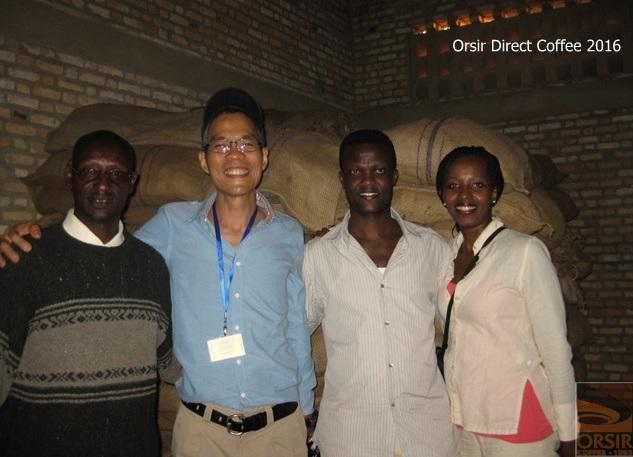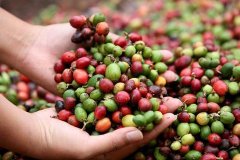Burundi Kajanza production area Champion washing Field-Panjaya Information Banja Champion small Farmer batch

For professional baristas, please follow the coffee workshop (Wechat official account cafe_style)
The photo should be taken in 2012, when I first visited this championship farm. Five years passed quickly. Burundi's coffee strength came to prominence on the international stage through the power of the Outstanding Cup. Coffee farmers also understand that continuous excellent quality is the only way to maintain competitiveness. For example, the batch fruit of 2015-16 is shown in the following photos. Red fruit represents the beginning of rigorous quality:

[about Burundi]
The original handmade drum is the best representative of this country, even coffee, they also use the term related to the drum.
The original, magnificent, exciting and uplifting drumming awakens the excitement of the coffee people. The Burundian drummer is a young and strong teenager who not only plays the drum but also jumps and dances, just like her coffee, which is admirable:
Burundi-the title of the Heart of Africa, Burundi (Burundi) is a small and primitive landlocked country with primitive beauty, located at the intersection of Central Africa and East African countries, and the watershed between Africa's great Nile and Congo River. the capital Bujumbura is located on the bank of the lake, with a view of the magnificent Lake Tanganyika, which is also her natural border with Congo and Tanzania. The lowest point is also more than 700m (772m) above sea level, located in Lake Tanganyika (Tanganyika), the highest elevation is 2670 Michael, located in the Heha Mountains, in 2012, I specially visited the coffee producing areas of this area, the original mountain view is very green.
The team has paid an in-depth visit to the Puguo production area since 2012. 2015-16 is a bumper harvest year, and there are 4 batches that can represent the local characteristics of Cayanza area.
Most people think that Burundian coffee should be similar to neighboring Rwanda, and most varieties are Bourbon, but it is not. In terms of acid quality, Rwanda is brighter, Burundian change is more delicate, delicate spice and sweet change is very unique, I once talked to Geoge Howell about Burundi, he told me clearly: he likes Burundian flavor, delicate change is better than Rwanda!
The coffee beans in the picture below represent the 17 provinces of Burundi. The capital Busombra is divided into metropolitan areas and suburbs. The red cherry pattern represents coffee production, mostly in the high north, crossing the border north to Rwanda.
Burundian citizens are not in the habit of drinking coffee, so when they found that growing coffee can bring cash income and improve the quality of life, they accepted the guidance of experts and the government. During the period of nationalization of the coffee industry, the Burundian government set up 138small washing stations in coffee-producing areas, which is estimated to have already exceeded 200CWS (Coffee Wash Station). CWS is set up like Rwanda, and there are no so-called "estates" in East Africa. Coffee farmers have very few coffee trees, ranging from dozens to more than 200, and they do not have the power to set up small peeled and pectin-free machine coffee (but it is common in Central America or Colombia). What they can do is, when the coffee cherries are ripe, they send them to CWS for treatment or sell them directly, so To discuss the quality of coffee in Rwanda or Burundi, we must use the CWS business model. Batches with good quality are tracked from the point of view of daily batch registration (DAY LOT). Just looking at the name of CWS to purchase, it is often distorted or even disappointed.
On top of CWS, a larger scale will be set up, similar to Kenya's large-scale processing plant Factory or cooperative Coop. The organization, but in Burundi, is called: Sogestal! Sogestal is the management integration unit of CWS, which is handled by CWS small washing station after receiving cherries, and the following steps, dry processing, grading, sales and other matters are handed over to Sogestal to do. After the coffee was opened to the public, the previous seven sogestal became a joint venture between state-owned and private enterprises. The current policy is for the government to reduce its shareholding, usually less than 20% by the government and more than 80% by the private sector.
The full text of SOGESTAL is Societies ManagingCoffee Washing Stations or Socio é t é de Gestion des Stations de Lavage du Caf é; it is Company for ManagingCoffee Washing Stations).
These seven SOGESTAL are mainly based on production areas and geographical areas, responsible for the management and post-processing of washing stations, and coordinate quality control and post-stage work and sales; they are: Kayanza, Kirimiro, Kirundo/Muyinga, Ngozi, Mumirwa, Sonicoff and Coprotra.
After the washing stage is completed and dried, the shell beans will be sent to the dry treatment plant, which is responsible for: preliminary grading, cup test, quality control report, and final grading and bagging. The main dry processing plants in the capital are SODECO, Sonocoff and Sivca.
Most of the coffee grown in Burundi belongs to bourbon species, and Jackson and other varieties have been introduced in recent years. Bourbon's aroma is obvious, the bourbon in Puguo is sweet enough and the acidity is elegant and not irritating, so it should be quite competitive in the international market, but before the civil strife and many problems led to the slow development of the industry, and the popularity of Burundi is not enough, so the evaluation of the international market is not enough. In 2005, I said that Burundi is like a buried pearl. I hope that from 2012, Burundi can become a dazzling pearl in the boutique coffee market.
The main and famous coffee producing areas in Puguo are Kayanza, Ngozi, Mumirwa, Buyenzi, Kirimiro and so on.
This batch of Burundians is from Kayanza District. Cajanza is located in the northern mountains. It takes about three hours to get to the capital. It takes about three hours to drive out of the suburbs and keep rising along the road, from 900m to 2500 meters above sea level, then slightly down to the visiting WCS, which is still 1800 Michael above sea level. The following is an interesting way to get to the Kayanza district, this welcome sign has the shape of a traditional Burundian drum, and another photo is a street view of Kayanza:
This batch of new beans comes from the champion processing field Panjaga Mpanga-SEGEC. The following picture shows the processing equipment after receiving cherries, the multi-trough and water channel design of Kenyan water washing method, and the vast and beautiful scaffolding suntan field:

The basic information of the following batch of Burundian Banja champion small farmers:
Country: Burundi
Production area: Kayanza
Processing field: Mpanga (I)-SEGEC-Kayanza Private CWS
Marked: Benga Orsir Direct Coffee- Banjia champion small farmers batch
Grade: FW A1
Harvest time: 2015
Treatment: washing method, natural solarization of back scaffolding
The cup test report is as follows: M0 baking degree (Cinnamon roast), baking time 12 minutes
Dry fragrance: honey, flowers, berries, sweet lime, sweet spices
Wet fragrance: flower fragrance, manor chocolate, honey sweet
Sipping: clean and delicate, honey sweet, flowers, vanilla plants, hazelnut chocolate, sweet white grapefruit, cranberries, delicate touch, delicate finish and long-lasting fruit spices.
Important Notice :
前街咖啡 FrontStreet Coffee has moved to new addredd:
FrontStreet Coffee Address: 315,Donghua East Road,GuangZhou
Tel:020 38364473
- Prev

Yega Xuefei Borinaya Cooperative Information introduction to the flavor characteristics of washed Yega Xuefei G1
For the exchange of professional baristas, please follow the coffee workshop (Wechat official account cafe_style) Ethiopia Oromia Yirgacheffe Washed G1 brief introduction of the newly arrived washing Yegashev is produced by more than 500 coffee farmers in the Borena district of the Onomian Cooperative. Since the Ethiopian government adopted the auction and regional marking method in ECX collection in 2010,
- Next

Yega Chuefei Bocacelinka Water washing Station Information introduction to the flavor and taste characteristics of water washing Yega
For the exchange of professional baristas, please follow the coffee workshop (Wechat official account cafe_style) Ethiopia Yirgacheffe Burka Silinga brief introduction 2016, Bokasilinka Yegashev, Ethiopia! Burka Silinga Micro lot! Yirgacheff- is a famous washed bean product in Ethiopia.
Related
- Detailed explanation of Jadeite planting Land in Panamanian Jadeite Manor introduction to the grading system of Jadeite competitive bidding, Red bid, Green bid and Rose Summer
- Story of Coffee planting in Brenka region of Costa Rica Stonehenge Manor anaerobic heavy honey treatment of flavor mouth
- What's on the barrel of Blue Mountain Coffee beans?
- Can American coffee also pull flowers? How to use hot American style to pull out a good-looking pattern?
- Can you make a cold extract with coffee beans? What is the right proportion for cold-extracted coffee formula?
- Indonesian PWN Gold Mandrine Coffee Origin Features Flavor How to Chong? Mandolin coffee is American.
- A brief introduction to the flavor characteristics of Brazilian yellow bourbon coffee beans
- What is the effect of different water quality on the flavor of cold-extracted coffee? What kind of water is best for brewing coffee?
- Why do you think of Rose Summer whenever you mention Panamanian coffee?
- Introduction to the characteristics of authentic blue mountain coffee bean producing areas? What is the CIB Coffee Authority in Jamaica?

